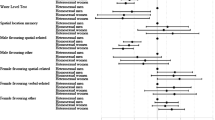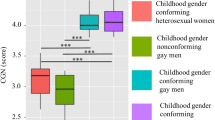Abstract
The present study explored whether there were relationships among gender nonconformity, intelligence, and sexual orientation. A total of 106 heterosexual men, 115 heterosexual women, and 103 gay men completed measures of demographic variables, recalled childhood gender nonconformity (CGN), and the National Adult Reading Test (NART). NART error scores were used to estimate Wechsler Adult Intelligence Scale (WAIS) Full-Scale IQ (FSIQ) and Verbal IQ (VIQ) scores. Gay men had significantly fewer NART errors than heterosexual men and women (controlling for years of education). In heterosexual men, correlational analysis revealed significant associations between CGN, NART, and FSIQ scores (elevated boyhood femininity correlated with higher IQ scores). In heterosexual women, the direction of the correlations between CGN and all IQ scores was reversed (elevated girlhood femininity correlating with lower IQ scores). There were no significant correlations among these variables in gay men. These data may indicate a “sexuality-specific” effect on general cognitive ability but with limitations. They also support growing evidence that quantitative measures of sex-atypicality are useful in the study of trait sexual orientation.
Similar content being viewed by others
Notes
The 10-item questionnaire is available from the corresponding author upon request.
References
Alanko, K., Santtila, P., Harlaar, N., Witting, K., Varjonen, M., Jern, P., et al. (2010). Common genetic effects of gender atypical behavior in childhood and sexual orientation in adulthood: A study of Finnish twins. Archives of Sexual Behavior, 39, 81–92.
Alanko, K., Santtila, P., Witting, K., Varjonen, M., Jern, P., Johansson, A., et al. (2009). Psychiatric symptoms and same-sex sexual attraction and behavior in light of childhood gender atypical behavior and parental relationships. Journal of Sex Research, 46, 494–504.
Bailey, J. M., Dunne, M. P., & Martin, N. G. (2000). Genetic and environmental influences on sexual orientation and its correlates in an Australian twin sample. Journal of Personality and Social Psychology, 78, 524–536.
Bailey, J. M., & Zucker, K. J. (1995). Childhood sex-typed behavior and sexual orientation: A conceptual analysis and quantitative review. Developmental Psychology, 31, 43–55.
Banks, G. C., Batchelor, J. H., & McDaniel, M. A. (2010). Smarter people are (a bit) more symmetrical: A meta-analysis of the relationship between intelligence and fluctuating asymmetry. Intelligence, 38, 393–401.
Blanchard, R., Kolla, N. J., Cantor, J. M., Klassen, P. E., Dickey, R., Kuban, M. E., et al. (2007). IQ, handedness, and pedophilia in adult male patients stratified by referral source. Sexual Abuse: A Journal of Research and Treatment, 19, 285–309.
Bright, P., Jaldow, E., & Kopelman, M. D. (2002). The National Adult Reading Test as a measure of premorbid intelligence: A comparison with estimates derived from demographic variables. Journal of the International Neuropsychological Society, 8, 847–854.
Camperio-Ciani, A., Corna, F., & Capiluppi, C. (2004). Evidence for maternally inherited factors favoring male homosexuality and promoting female fecundity. Proceedings of the Royal Society of London Series B: Biological Sciences, 271, 2217–2221.
Cantor, J. M., Blanchard, R., Christensen, B. K., Dickey, R., Klassen, P. E., Beckstead, A. L., et al. (2004). Intelligence, memory, and handedness in pedophilia. Neuropsychology, 18, 3–14.
Cantor, J. M., Blanchard, R., Robichaud, L. K., & Christensen, B. K. (2005). Quantitative reanalysis of aggregate data on IQ in sexual offenders. Psychological Bulletin, 131, 555–568.
Cardoso, F. L. (2009). Recalled sex-typed behavior in childhood and sports’ preferences in adulthood of heterosexual, bisexual, and homosexual men from Brazil, Turkey, and Thailand. Archives of Sexual Behavior, 38, 726–736.
Cohen, J. (1988). Statistical power analysis for the behavioral sciences (2nd ed.). Hillsdale, NJ: Erlbaum.
Collaer, M. L., Reimers, S., & Manning, J. T. (2007). Visuospatial performance on an internet line judgment task and potential hormonal markers: Sex, sexual orientation, and 2D:4D. Archives of Sexual Behavior, 36, 177–192.
Crawford, J. R., Deary, I. J., Starr, J. M., & Whalley, L. J. (2001). The NART as an index of prior intellectual functioning: A retrospective validity study covering a 66 year interval. Psychological Medicine, 31, 451–458.
Crawford, J. R., Parker, D. M., Allan, K. M., Jack, A. M., & Morrison, F. M. (1991). The short NART: Cross validation, relationship to IQ and some practical considerations. British Journal of Clinical Psychology, 30, 223–229.
Crawford, J. R., Parker, D. M., Stewart, L. E., Besson, J. A. O., & De Lacy, G. (1989). Prediction of WAIS IQ with National Adult Reading Test: Cross-validation and extension. British Journal of Clinical Psychology, 28, 267–273.
Crawford, J. R., Stewart, L. E., Cochrane, R. H. B., Parker, D. M., & Beeson, J. A. (1989). Construct validity of the National Adult Reading Test: A factor analytic study. Personality and Individual Differences, 10, 585–587.
Deary, I. J., Whalley, L. J., & Crawford, J. R. (2004). An ‘instantaneous’ estimate of a lifetime’s cognitive change. Intelligence, 32, 113–119.
Dunne, M. P., Bailey, J. M., Kirk, K. M., & Martin, N. G. (2000). The subtlety of sexual orientation. Archives of Sexual Behavior, 29, 549–565.
Finegan, J. K., Zucker, K. J., Bradley, S. J., & Doering, R. W. (1982). Patterns of intellectual functioning and spatial ability in boys with gender identity disorder. Canadian Journal of Psychiatry, 27, 135–139.
Frisell, T., Lichtenstein, P., Rahman, Q., & Långström, N. (2010). Psychiatric morbidity associated with same-sex sexual behavior: Influence of minority stress and familial factors. Psychological Medicine, 40, 315–324.
Gladue, B. A., & Bailey, J. M. (1995). Spatial ability, handedness and human sexual orientation. Psychoneuroendocrinology, 20, 487–497.
Gladue, B. A., Beatty, W. W., Larson, J., & Staton, R. D. (1990). Sexual orientation and spatial ability in men and women. Psychobiology, 18, 101–108.
Green, R. (1987). The “sissy boy syndrome” and the development of homosexuality. New Haven, CT: Yale University Press.
Hassan, B., & Rahman, Q. (2007). Selective sexual orientation-related differences in object location memory. Behavioral Neuroscience, 121, 625–633.
Lalumiére, M. L., Blanchard, R., & Zucker, K. J. (2000). Sexual orientation and handedness in men and women: A meta-analysis. Psychological Bulletin, 126, 575–592.
Lezak, M. D. (1995). Neuropsychological assessment (3rd ed.). London: Oxford University Press.
Lippa, R. (1998). Gender-related individual differences and National Merit test performance: Girls who are “masculine” and boys who are “feminine” tend to do better. In L. Ellis & L. Ebertz (Eds.), Males, females, and behavior: Toward biological understanding (pp. 177–193). Westport, CT: Praeger.
McCormick, C. M., & Witelson, S. F. (1991). A cognitive profile of homosexual men compared to heterosexual men and women. Psychoneuroendocrinology, 15, 459–473.
Meyer-Bahlburg, H. F. L., Dolezal, C., Zucker, K. J., Kessler, S. J., Schober, J. M., & New, M. I. (2006). The Recalled Childhood Gender Questionnaire-revised: A psychometric analysis in a sample of women with congenital adrenal hyperplasia. Journal of Sex Research, 43, 364–367.
Money, J., & Epstein, R. (1967). Verbal aptitude in eonism and pre-pubertal effeminacy—a feminine trait. Transactions of the New York Academy of Sciences, 29, 448–454.
Neave, N., Menaged, M., & Weightman, D. R. (1999). Sex differences in cognition: The role of testosterone and sexual orientation. Brain and Cognition, 41, 245–262.
Nelson, H. E. (1982). The National Adult Reading Test (NART): The manual. Windsor: NFER-Nelson.
Oldfield, R. C. (1971). The assessment and analysis of handedness: The Edinburgh Inventory. Neuropsychologia, 9, 97–113.
Plöderl, M., & Fartacek, R. (2009). Childhood gender nonconformity and harassment as predictors of suicidality among gay, lesbian, bisexual, and heterosexual Austrians. Archives of Sexual Behavior, 38, 400–410.
Rahman, Q., Abrahams, S., & Wilson, G. D. (2003). Sexual orientation-related differences in verbal fluency. Neuropsychology, 17, 240–246.
Rahman, Q., Clarke, K., & Morera, T. (2009). Hair whorl direction and sexual orientation in human males. Behavioral Neuroscience, 123, 252–256.
Rahman, Q., & Koerting, J. (2008). Sexual orientation-related differences in allocentric spatial memory tasks. Hippocampus, 18, 55–63.
Rahman, Q., & Wilson, G. D. (2003). Large sexual orientation related differences in performance on mental rotation and judgement of line orientation. Neuropsychology, 17, 25–31.
Rahman, Q., Wilson, G. D., & Abrahams, S. (2003). Sexual orientation related differences in spatial memory. Journal of the International Neuropsychological Society, 9, 376–383.
Rieger, G., Linsenmeier, J. A. W., Gygax, L., & Bailey, J. M. (2008). Sexual orientation and childhood gender nonconformity: Evidence from home videos. Developmental Psychology, 44, 46–58.
Sanders, G., & Ross-Field, L. (1986). Sexual orientation and visuo-spatial ability. Brain and Cognition, 5, 280–290.
Sanders, G., & Ross-Field, L. (1987). Neuropsychological development of cognitive abilities: A new research strategy and some preliminary evidence for a sexual orientation model. International Journal of Neuroscience, 36, 1–16.
Sanders, G., & Wright, M. (1997). Sexual orientation differences in cerebral asymmetry and in the performance of sexually dimorphic cognitive and motor tasks. Archives of Sexual Behavior, 26, 463–480.
Singer, J. J., MacGregor, A. J., Cherkas, L. F., & Spector, T. D. (2006). Genetic influences of cognitive function using the Cambridge Neuropsychological Test Automated Battery. Intelligence, 34, 421–428.
Tuttle, G. E., & Pillard, R. C. (1991). Sexual orientation and cognitive abilities. Archives of Sexual Behavior, 20, 307–318.
Wegesin, D. J. (1998). A neuropsychologic profile of homosexual and heterosexual men and women. Archives of Sexual Behavior, 27, 91–108.
Weinrich, J. D. (1978). Nonreproduction, homosexuality, transsexuality and intelligence: I. A systematic literature search. Journal of Homosexuality, 3, 275–289.
Weinrich, J. D. (1979). On the relationship between homosexuality and IQ test scores: A review and some hypotheses. In R. Forleo & W. Pasini (Eds.), Medical sexology: The third international congress (pp. 312–317). Littleton, MA: PSG Publishing Co.
Willmott, M., & Brierley, H. (1984). Cognitive characteristics and homosexuality. Archives of Sexual Behavior, 13, 311–319.
Willshire, D., Kinsella, G., & Prior, M. (1991). Estimating WAIS-R IQ from the National Adult Reading Test: A cross-validation. Journal of Clinical and Experimental Neuropsychology, 13, 204–2016.
Zucker, K. J., & Bradley, S. J. (1995). Gender identity disorder and psychosexual problems in children and adolescents. New York: Guilford.
Zucker, K. J., Mitchell, J. N., Bradley, S. J., Tkachuk, J., Cantor, J. M., & Allin, S. M. (2006). The Recalled Childhood Gender Identity/Gender Role Questionnaire: Psychometric properties. Sex Roles, 54, 469–483.
Author information
Authors and Affiliations
Corresponding author
Rights and permissions
About this article
Cite this article
Rahman, Q., Bhanot, S., Emrith-Small, H. et al. Gender Nonconformity, Intelligence, and Sexual Orientation. Arch Sex Behav 41, 623–630 (2012). https://doi.org/10.1007/s10508-011-9737-1
Received:
Revised:
Accepted:
Published:
Issue Date:
DOI: https://doi.org/10.1007/s10508-011-9737-1




